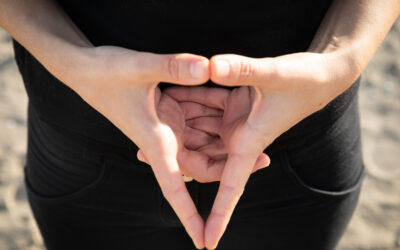Chin Mudra which is also known as the Gesture of Consciousness, is a powerful hand gesture commonly used in yoga & meditation practices. This mudra is believed to stimulate various energy channels in the body, promoting physical & mental wellbeing. In this article, we will explore the benefits of Chin Mudra, its potential side effects, correct method of performing it & any contraindications that should be kept in mind. Whether you are a seasoned yogi or a beginner looking to enhance your mindfulness practice, understanding the intricacies of Chin Mudra can offer you a deeper connection to yourself & the world around you.
Benefits of Chin Mudra.
The Chin Mudra is a simple yet powerful gesture carries following numerous benefits for both the mind & body:
1. Enhances Concentration.
Practicing Chin Mudra helps to improve focus & concentration. By joining the thumb and index finger, it stimulates the energy flow in the brain & activates the corresponding areas responsible for concentration and memory.
This can be particularly beneficial for students, professionals & anyone seeking to enhance their cognitive abilities.
2. Calms the Mind.
The Chin Mudra has a calming effect on the mind. The connection created between the thumb & index finger helps to redirect energy & reduce restlessness. This gesture helps in managing stress, anxiety & emotional disturbances, allowing for a more peaceful & relaxed state of mind.
3. Stimulates Prana Flow.
Prana refers to the vital life force energy present in our body. Chin Mudra helps in activating & regulating the flow of prana throughout the body. By creating a circuit between the thumb (representing fire) and the index finger (representing air), the energy flow is balanced, promoting overall wellbeing & vitality.
4. Balances the Elements.
According to yogic philosophy each finger represents one of the five elements—thumb represents fire, index finger represents air, middle finger represents ether, ring finger represents earth & little finger represents water.
By connecting the thumb and index finger in Chin Mudra, the fire & air elements are joined, bringing about a harmonious balance between these two elements. This balance helps to maintain equilibrium within the body and mind.
5. Promotes Inner Awareness.
The Chin Mudra is often used during meditation practices to deepen awareness & connection with one’s inner self. It aids in turning inward & disconnecting from external distractions, allowing for a more profound experience of self realization & spiritual growth.
6. Improves Digestion.
The Chin Mudra has a positive impact on the digestive system. The fire element associated with the thumb helps to stimulate the Agni (digestive fire) in the body, leading to improved digestion & absorption of nutrients. It can be particularly helpful for individuals struggling with digestive issues or sluggish metabolism.
7. Balances Energy Flow.
Chin Mudra helps to balance the flow of energy throughout the body. The closed circuit created by joining the thumb & index finger allows energy to circulate efficiently, ensuring that all meridians and energy centers are evenly nourished. This balanced energy flow contributes to overall physical & mental wellbeing.
8. Benefits of Chin Mudra for Hair.
By practicing this mudra regularly, it is believed to stimulate blood circulation in the scalp, thus promoting hair growth. Additionally, the Chin mudra is known to balance the elements within the body, leading to a healthier scalp environment & reducing the likelihood of hair problems such as dandruff or dryness.
Moreover, this gesture is said to calm the mind & reduce stress levels, which can be beneficial as stress is a common cause of hair loss. Overall, incorporating the Chin mudra into a daily routine can help to nourish the hair from within & contribute to lustrous, vibrant locks.
| 💡 Tips FreakToFit.com Incorporating Chin Mudra into your daily yoga or meditation practice can provide a multitude of benefits, promoting mental clarity, emotional stability & physical health. Its simplicity makes it accessible to practitioners of all levels, allowing anyone to tap into its transformative power. |
Side Effects of Chin Mudra.
The chin mudra, a revered hand gesture in yoga and meditation practices, is not only known for its spiritual significance but also for its potential side effects. While the chin mudra is generally safe and beneficial, it is essential to be aware of potential adverse effects that may arise from its practice.
1. Muscle Strain.
The chin mudra requires the practitioner to bring the thumb & index finger together while keeping the other fingers extended.
Maintaining this hand position for an extended period may lead to muscle strain or fatigue in the hand and forearm muscles, particularly if practiced excessively or in an incorrect posture.
2. Reduced Blood Flow.
By pressing the thumb & index finger together, the chin mudra can create slight pressure on the nerves and blood vessels.
This pressure, if applied too forcefully or for a prolonged duration, may reduce blood flow to the fingertips, leading to numbness or tingling sensations. It is crucial to find a balance between applying gentle pressure and avoiding excessive force.
3. Joint Discomfort.
People with pre existing joint conditions like arthritis or carpal tunnel syndrome, may experience discomfort or pain in the fingers, wrists or hands when practicing the chin mudra.
It is advisable for individuals with joint issues to consult their healthcare provider or a qualified yoga instructor before incorporating this mudra into their practice.
4. Distraction & Focus Disruption.
While the chin mudra is intended to enhance concentration & focus during meditation, some individuals may find it distracting or difficult to maintain.
The constant awareness of the hand position may divert attention away from the intended meditation object or practice. It is important to experiment with different hand gestures & find the one that best supports one’s meditation practice.
5. Emotional Release.
The chin mudra like many other mudras, is believed to stimulate certain energy channels or centers in the body. As a result, some individuals may experience emotional release during or after practicing this mudra.
Emotions like sadness, anger or joy may arise unexpectedly & it is important to approach these experiences with openness and self compassion.
6. Energetic Imbalances.
In rare cases the chin mudra may create energetic imbalances in the body, particularly when performed without proper guidance or in excess. These imbalances can manifest as increased restlessness, agitation or disrupted sleep patterns.
If such imbalances occur, it is advisable to discontinue the practice temporarily & seek guidance from an experienced yoga teacher or healthcare professional.
| 💡 Tips FreakToFit.com It is essential to approach the practice of the chin mudra with mindfulness, respect for one’s body & self awareness. If any discomfort or side effects arise, it is recommended to consult a healthcare professional or qualified yoga instructor to address any concerns & ensure a safe and beneficial practice. |
How To Do Chin Mudra?
To perform Chin Mudra, follow these steps:
1. Find a Comfortable Seated Position.
Sit on a yoga mat or cushion with your spine erect & shoulders relaxed. You can cross your legs or sit on a chair, whatever feels most comfortable for you.
2. Relax Your Hands.
Place your hands on your thighs, palms facing up. Allow your fingers to naturally curl & relax.
3. Bring Your Thumb & Index finger Together.
Gently touch the tip of your thumb to the tip of your index finger, creating a circle or ring shape. The remaining three fingers can be softly extended or slightly bent, whichever feels more natural.
4. Maintain a Relaxed Grip.
Apply a gentle pressure between the thumb & index finger but avoid exerting too much force. The grip should be firm enough to maintain the connection, yet light enough to allow for free flow of energy.
5. Rest Your Hands on Your Thighs.
Keep your hands relaxed & rest them on your thighs, palms facing up. This position helps to balance the energy flow in your body & allows for a deeper connection with your inner self.
6. Find a Comfortable Gaze.
Soften your gaze or gently close your eyes, whichever feels more comfortable for you. This helps to redirect your focus inward & promotes a sense of inner peace & tranquility.
7. Breathe Deeply & Relax.
Take a few deep breaths, inhale through your nose & exhale through your mouth. Allow your body to relax with each breath, letting go of any tension or stress.
8. Hold the Mudra for a Few Minutes.
Maintain the Chin Mudra for as long as it feels comfortable, typically for a few minutes or longer if desired. You can incorporate it into your yoga or meditation practice or simply practice it on its own to experience its benefits.
| 💡 Tips FreakToFit.com Remember, Chin Mudra is not only a hand gesture but also a symbol of connection & unity. It signifies the union of individual consciousness with universal consciousness, fostering a sense of harmony and balance within oneself. Regular practice of Chin Mudra can help to deepen your spiritual practice and bring about a profound sense of inner peace & clarity. |
Chin Mudra Contraindications.
Chin Mudra, although a highly beneficial and widely practiced hand gesture in yoga and meditation, does carry a few contraindications that should be taken into consideration. These contraindications primarily revolve around individuals with certain health conditions or injuries that may be aggravated by the practice of Chin Mudra.
1. Hypertension.
People with high blood pressure should exercise caution while performing Chin Mudra. This hand gesture is known to increase blood flow to the head & face, which may temporarily elevate blood pressure levels. It is advisable for individuals with hypertension to consult with a healthcare professional before engaging in this practice.
2. Migraines or Severe Headaches.
Chin Mudra involves placing the thumb & index finger together while extending the other three fingers. This hand position can create a subtle energy flow, which may trigger or intensify migraines or severe headaches in some individuals. If prone to such conditions, it is recommended to avoid Chin Mudra or proceed with caution.
3. Hand or Wrist Injuries.
People with hand or wrist injuries like fractures, sprains or carpal tunnel syndrome, should refrain from performing Chin Mudra until the injury has healed completely. The pressure exerted on the fingers & wrist during this hand gesture may cause discomfort or worsen the existing condition.
4. Pregnancy.
Pregnant women should approach Chin Mudra with care, especially during the later stages of pregnancy. This hand gesture is believed to stimulate the energy flow in the body, which may have certain effects on the uterus or hormonal balance.
Consultation with a qualified prenatal yoga instructor or healthcare provider is recommended before practicing Chin Mudra during pregnancy.
5. Psychological Conditions.
Individuals with certain psychological conditions like severe anxiety, panic disorders or obsessive compulsive disorders, may find that the hand position of Chin Mudra exacerbates their symptoms. It is advisable for individuals with such conditions to seek guidance from a mental health professional before incorporating this hand gesture into their practice.
| 💡 Tips FreakToFit.com While Chin Mudra is generally safe & beneficial for most individuals, it is important to be aware of these contraindications and to listen to your body’s signals. If you experience any discomfort or worsening of symptoms, it is recommended to discontinue the practice & consult with a healthcare professional. |
My Personal Experience on Chin Mudra.
Personally, practicing Chin Mudra has been a transformative experience for me. This simple yet powerful gesture has helped me to enhance my focus & concentration during meditation sessions.
By creating a connection between the index finger & the thumb, I feel a sense of unity within myself, promoting a deeper connection with my inner self & the present moment.
The Chin Mudra also aids in calming my mind & reducing stress, allowing me to enter a state of deep relaxation and inner peace.
Overall, incorporating Chin Mudra into my yoga & meditation practice has significantly enriched my experience, helping me to connect with my inner self & cultivate a sense of tranquility and mindfulness.
Frequently Asked Questions.
Yes, the Chin Mudra can be practiced in any seated position like cross legged or in a chair. It can also be practiced while lying down, as long as you can comfortably maintain the hand gesture.
The duration of holding the Chin Mudra can vary depending on personal preference & the specific meditation practice. It is common to hold the hand gesture for the entire duration of the meditation practice, but you can also release it whenever you feel necessary.
Yes, the Chin Mudra can be combined with other hand gestures known as mudras, to enhance specific intentions or goals during meditation. It is important to learn & practice mudras under the guidance of a qualified teacher.
While the Chin Mudra is primarily used during meditation & yoga practices, you can also incorporate it into daily tasks to bring a sense of mindfulness & focus. However, be mindful of your surroundings and ensure it doesn’t interfere with the task at hand.
Children can also practice the Chin Mudra but they may require guidance & supervision to ensure they understand the purpose and proper technique. It can be a helpful tool to introduce mindfulness & relaxation to children.
The Chin Mudra is believed to activate the energy centers in the body, promote mental clarity & reduce stress. It is also improve digestion, enhance breathing & balance the flow of energy throughout the body.
Bottom Line.
The Chin Mudra is a powerful & ancient hand gesture that holds deep spiritual significance. It is commonly used in various forms of meditation and yoga practices to enhance focus, concentration and inner peace. The practice of this mudra helps to balance & harmonize the energy within the body, leading to a sense of clarity and tranquility. By incorporating the Chin Mudra into our daily lives, we can cultivate a deeper connection with ourselves and the world around us, promoting overall wellbeing and spiritual growth.

 Workout
Workout
 Meditation
Meditation


 Stories
Stories


 Podcast
Podcast E-book
E-book










